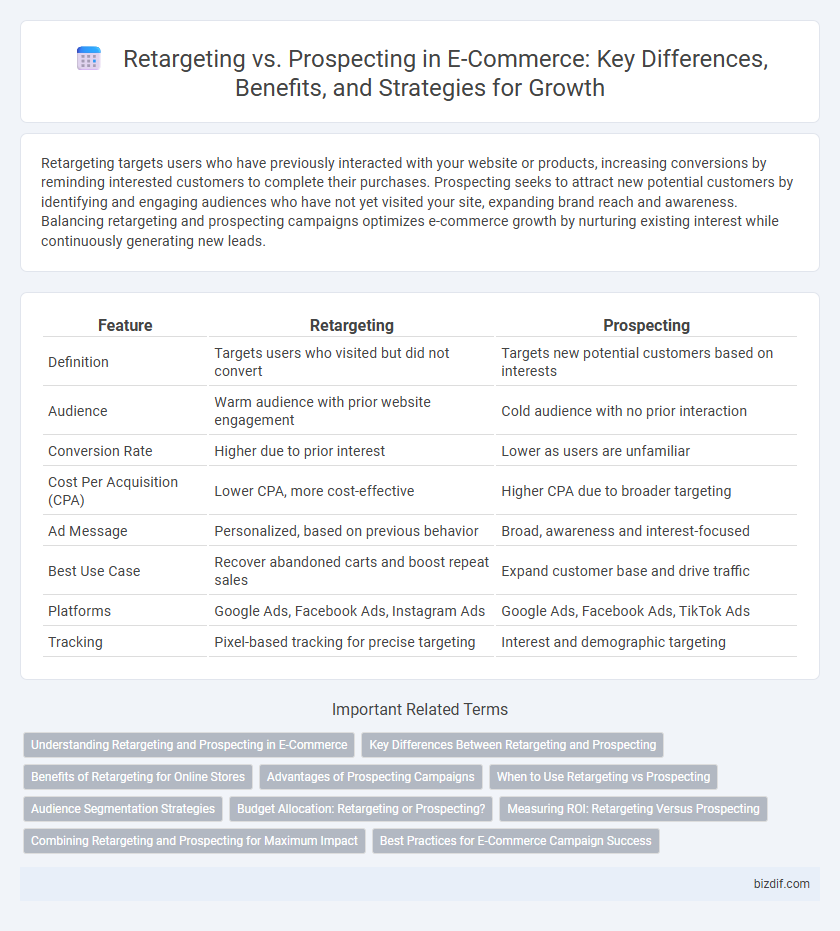Retargeting targets users who have previously interacted with your website or products, increasing conversions by reminding interested customers to complete their purchases. Prospecting seeks to attract new potential customers by identifying and engaging audiences who have not yet visited your site, expanding brand reach and awareness. Balancing retargeting and prospecting campaigns optimizes e-commerce growth by nurturing existing interest while continuously generating new leads.
Table of Comparison
| Feature | Retargeting | Prospecting |
|---|---|---|
| Definition | Targets users who visited but did not convert | Targets new potential customers based on interests |
| Audience | Warm audience with prior website engagement | Cold audience with no prior interaction |
| Conversion Rate | Higher due to prior interest | Lower as users are unfamiliar |
| Cost Per Acquisition (CPA) | Lower CPA, more cost-effective | Higher CPA due to broader targeting |
| Ad Message | Personalized, based on previous behavior | Broad, awareness and interest-focused |
| Best Use Case | Recover abandoned carts and boost repeat sales | Expand customer base and drive traffic |
| Platforms | Google Ads, Facebook Ads, Instagram Ads | Google Ads, Facebook Ads, TikTok Ads |
| Tracking | Pixel-based tracking for precise targeting | Interest and demographic targeting |
Understanding Retargeting and Prospecting in E-Commerce
Retargeting in e-commerce targets users who have previously interacted with a website or product, aiming to convert interest into sales through personalized ads. Prospecting involves identifying and attracting new potential customers using data-driven audience segmentation and broad targeting strategies. Both approaches leverage customer behavior analytics to optimize ad spend and enhance conversion rates effectively.
Key Differences Between Retargeting and Prospecting
Retargeting targets users who have already interacted with your e-commerce site, using personalized ads to drive conversions and increase customer retention. Prospecting aims to reach new potential customers through broader audience targeting based on demographics, interests, and behavior patterns to expand brand awareness. While retargeting focuses on converting warm leads, prospecting is essential for generating fresh traffic and growing your customer base.
Benefits of Retargeting for Online Stores
Retargeting delivers higher conversion rates by targeting users who have already shown interest in products, increasing the likelihood of purchase for online stores. This strategy enhances return on ad spend (ROAS) by re-engaging warm audiences through personalized ads across multiple platforms. Leveraging behavioral data, retargeting reduces cart abandonment and boosts customer lifetime value with timely, relevant promotions.
Advantages of Prospecting Campaigns
Prospecting campaigns in e-commerce expand the customer base by targeting new audiences who have not yet engaged with the brand, increasing brand awareness and potential sales opportunities. These campaigns leverage data-driven targeting strategies such as lookalike audiences and interest-based segments to attract high-intent shoppers. Compared to retargeting, prospecting provides long-term growth by continuously injecting fresh leads into the sales funnel and reducing dependency on existing website visitors.
When to Use Retargeting vs Prospecting
Use retargeting when aiming to convert visitors who have already interacted with your e-commerce site but didn't complete a purchase, leveraging personalized ads to remind and incentivize them. Prospecting is essential for expanding your customer base by targeting new potential buyers based on demographic and behavioral data relevant to your product niche. Employ retargeting for high-intent audiences and prospecting to build brand awareness and audience reach in untapped markets.
Audience Segmentation Strategies
Retargeting leverages behavior-based audience segmentation by targeting previous website visitors or shoppers who showed interest but did not convert, increasing the likelihood of purchase through personalized ads. Prospecting uses demographic, psychographic, and interest-based segmentation to identify and attract new potential customers who have not yet interacted with the brand. Effective e-commerce audience segmentation strategies combine retargeting's precision with prospecting's broad reach to maximize customer acquisition and conversion rates.
Budget Allocation: Retargeting or Prospecting?
Allocating budget in e-commerce between retargeting and prospecting depends on campaign goals and customer journey stages. Retargeting leverages higher conversion rates by focusing spend on visitors who have already shown interest, making it cost-efficient for driving sales. Prospecting expands reach to new customers but often requires a larger budget due to lower initial engagement and conversion rates.
Measuring ROI: Retargeting Versus Prospecting
Measuring ROI in e-commerce reveals distinct advantages for retargeting, as it typically yields higher conversion rates by targeting users already familiar with a brand, resulting in more efficient ad spend. Prospecting campaigns, while essential for expanding reach and acquiring new customers, often show lower immediate ROI due to broader targeting and longer customer acquisition cycles. Effective ROI analysis requires tracking metrics such as cost per acquisition (CPA), click-through rate (CTR), and lifetime value (LTV) to optimize the balance between retargeting's precision and prospecting's growth potential.
Combining Retargeting and Prospecting for Maximum Impact
Combining retargeting and prospecting strategies in e-commerce leverages the strengths of both to maximize customer acquisition and retention. Retargeting focuses on re-engaging users who have already shown interest, increasing conversion rates through personalized ads, while prospecting expands the audience by targeting new potential customers using data-driven segments. Integrating these approaches enhances overall campaign efficiency, driving higher ROI and sustained growth by nurturing prospects into loyal buyers.
Best Practices for E-Commerce Campaign Success
Retargeting campaigns in e-commerce focus on re-engaging users who have previously interacted with your website, leveraging personalized ads to increase conversion rates and maximize ROI. Prospecting campaigns target new potential customers by using audience segmentation and lookalike modeling to expand market reach and acquire high-quality traffic. Combining dynamic product ads with clear call-to-actions optimizes both strategies, driving sustained growth and improved customer lifetime value.
Retargeting vs Prospecting Infographic

 bizdif.com
bizdif.com